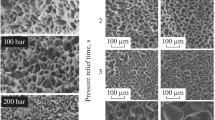Abstract
To investigate in detail the “black prosthesis” syndrome, experimental production of melanin from epinephrine was performed both in bulk and onto the surface of a common prosthetic material, poly(methyl methacrylate) (PMMA). The study by ultraviolet/visible spectrometry showed that the radiation-absorptive properties of PMMA were significantly enhanced; a sample treated for 20 days in epinephrine absorbed all ultraviolet radiation up to a 344-nm wavelength and transmitted only 4.9% from the ultraviolet spectrum at 400 nm and 16.2% from the visible spectrum at 500 nm. Transmission electron microscopy studies suggest that melanogenesis occurs on the surface of PMMA, and the pigment does not penetrate the polymer. Using infrared spectrometry, it was confirmed that the pigmentation is caused by a melanin formed through the oxidative polymerization of epinephrine.
Similar content being viewed by others
References
Barrie JA (1968) Water in polymers. In: Cranck J, Park GS (eds) Diffusion in polymers. Academic Press, London, pp 259–313
Bu'Lock JD (1961) The formation of melanin from adrenochrome. J Chem Soc 52–58
Cleasby G, Donaldson DD (1967) Epinephrine pigmentation of the cornea. Feature photo. Arch Ophthalmol 78:74–76
Corwin ME, Spencer WH (1963) Conjunctival melanin depositions. A side-effect of topical epinephrine therapy. Arch Ophthalmol 69:317–321
Davidson SI (1974) Systemic effects of eye drops. Trans Ophthalmol Soc UK 94:487–495
Drance SM, Ross RA (1970) The ocular effects of epinephrine. Surv Ophthalmol 14:330–335
Ferry JF (1967) Black prosthesis. A complication of the topical use of epinephrine. Am J Ophthalmol 64:162
Ferry AP, Zimmerman LE (1964) Black cornea: a complication of topical use of epinephrine. Am J Ophthalmol 58:205–210
Harley-Mason J (1950) The chemistry of adrenochrome and its derivatives. J Chem Soc 1276–1282
Krejci L, Harrison R (1969) Corneal pigment deposits from topically administered epinephrine. Experimental production. Arch Ophthalmol 82:836–839
Lowenstein A (1927) Künstliche Hervorrufung melanotischer Geschwulstchen in der Bindehaut. Ber Dtsch Ophthalmol Ges 46:439–441
Madge GE, Geeraets WJ, Guerry D (1971) Black cornea secondary to topical epinephrine. Am J Ophthalmol 71:402–405
Miller D, Brooks SM, Mobilia E (1976) Adrenochrome staining of soft contact lenses. Ann Ophthalmol 8:65–67
Mooney D (1970) Pigmentation after long-term topical use of adrenaline compounds. Br J Ophthalmol 54:823–826
Pardos GJ, Krachmer JH, Mannis MJ (1980) Persistent corneal erosion secondary to tarsal adrenochrome deposit. Am J Ophthalmol 90:870–871
Reinecke RD, Kuwabara T (1963) Corneal deposits secondary to topical epinephrine. Arch Ophthalmol 70:170–172
Rogers CA (1985) Permeation of gases and vapours in polymers. In: Comyn J (ed) Polymer permeability. Elsevier, London New York, pp 11–73
Spaeth GL (1967) Nasolacrimal duct obstruction caused by topical epinephrine. Arch Ophthalmol 77:355–357
Spiers F, Eldrup-Jorgensen P (1966) External side-effects by Eppy. Trans Ophthalmol Soc UK 86:255–260
Sugar J (1974) Adrenochrome pigmentation of hydrophilic lenses. Arch Ophthalmol 91:11–12
Swan GA (1974) Structure, chemistry and biosynthesis of the melanins. Prog Chem Org Nat Prod 31:521–582
Thomas AM (1951) Moisture permeability, diffusion and sorption in organic film-forming materials. J Appl Chem 1:141–158
Author information
Authors and Affiliations
Additional information
Offprint requests to: T.V. Chirila
Rights and permissions
About this article
Cite this article
Chirila, T.V., Cooper, h.L., Constable, I.J. et al. “Black prosthesis” revisited: a study of epinephrine-induced pigment deposits on poly(methyl methacrylate). Graefe's Arch Clin Exp Ophthalmol 229, 578–582 (1991). https://doi.org/10.1007/BF00203325
Received:
Accepted:
Issue Date:
DOI: https://doi.org/10.1007/BF00203325




